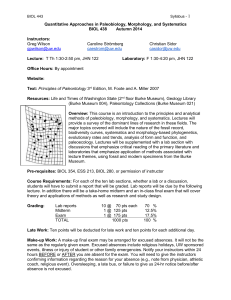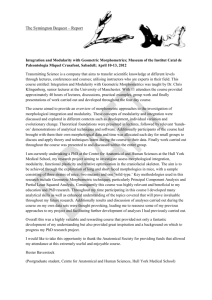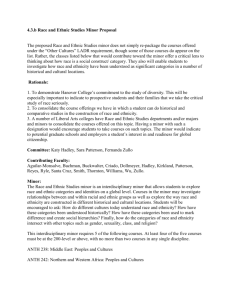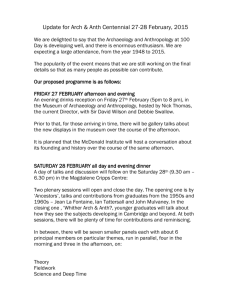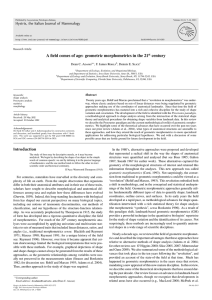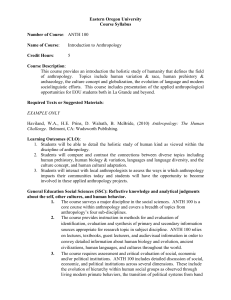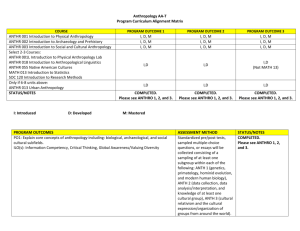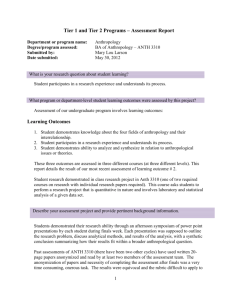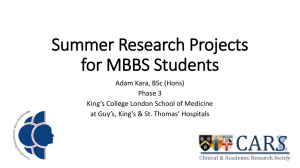The Same but different: human Biological Variation
advertisement
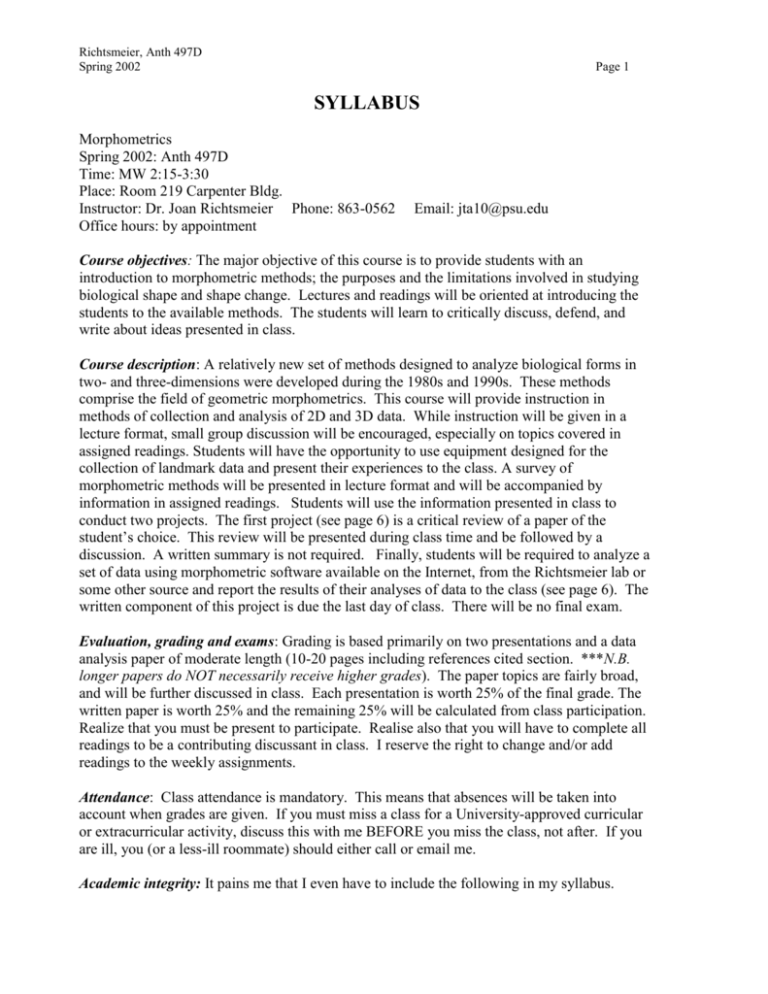
Richtsmeier, Anth 497D Spring 2002 Page 1 SYLLABUS Morphometrics Spring 2002: Anth 497D Time: MW 2:15-3:30 Place: Room 219 Carpenter Bldg. Instructor: Dr. Joan Richtsmeier Phone: 863-0562 Office hours: by appointment Email: jta10@psu.edu Course objectives: The major objective of this course is to provide students with an introduction to morphometric methods; the purposes and the limitations involved in studying biological shape and shape change. Lectures and readings will be oriented at introducing the students to the available methods. The students will learn to critically discuss, defend, and write about ideas presented in class. Course description: A relatively new set of methods designed to analyze biological forms in two- and three-dimensions were developed during the 1980s and 1990s. These methods comprise the field of geometric morphometrics. This course will provide instruction in methods of collection and analysis of 2D and 3D data. While instruction will be given in a lecture format, small group discussion will be encouraged, especially on topics covered in assigned readings. Students will have the opportunity to use equipment designed for the collection of landmark data and present their experiences to the class. A survey of morphometric methods will be presented in lecture format and will be accompanied by information in assigned readings. Students will use the information presented in class to conduct two projects. The first project (see page 6) is a critical review of a paper of the student’s choice. This review will be presented during class time and be followed by a discussion. A written summary is not required. Finally, students will be required to analyze a set of data using morphometric software available on the Internet, from the Richtsmeier lab or some other source and report the results of their analyses of data to the class (see page 6). The written component of this project is due the last day of class. There will be no final exam. Evaluation, grading and exams: Grading is based primarily on two presentations and a data analysis paper of moderate length (10-20 pages including references cited section. ***N.B. longer papers do NOT necessarily receive higher grades). The paper topics are fairly broad, and will be further discussed in class. Each presentation is worth 25% of the final grade. The written paper is worth 25% and the remaining 25% will be calculated from class participation. Realize that you must be present to participate. Realise also that you will have to complete all readings to be a contributing discussant in class. I reserve the right to change and/or add readings to the weekly assignments. Attendance: Class attendance is mandatory. This means that absences will be taken into account when grades are given. If you must miss a class for a University-approved curricular or extracurricular activity, discuss this with me BEFORE you miss the class, not after. If you are ill, you (or a less-ill roommate) should either call or email me. Academic integrity: It pains me that I even have to include the following in my syllabus. Richtsmeier, Anth 497D Spring 2002 Page 2 Penn State defines academic integrity as the pursuit of scholarly activity in an open, honest and responsible manner. All students should act with personal integrity, respect other students’ dignity, rights and property, and help create and maintain an environment in which all can succeed by their own efforts. In this class especially, respect for each other’s ideas, history and dignity is expected and required. My hope would be that this behavior might spill over into your everyday (out-of-the-classroom) life. Dishonesty of any kind will not be tolerated in this course. Dishonesty includes but is not limited to cheating, plagiarizing, fabricating information or citations, facilitating acts of academic dishonesty by others, submitting work of another person or work previously used without informing the instructor, or tampering with the academic work of other students. Students who are found to be dishonest will receive academic sanctions and will be reported to the University’s Judicial Affairs office for possible further disciplinary sanction. Disability Access Statement: Penn State encourages qualified people with disabilities to participate in its programs and activities and is committed to the policy that all people shall have equal access to programs, facilities, and admissions without regard to personal characteristics not related to ability, performance, or qualifications as determined by University policy or by state or federal authorities. If you anticipate needing any type of accommodation in this course or have questions about physical access, please tell Dr. Richtsmeier as soon as possible (i.e., TODAY). Course Materials: Xeroxed copies or pdf versions of articles will be made available to you. Richtsmeier, Anth 497D Spring 2002 COURSE SCHEDULE Class date Reading assignment DUE January 8 Page 3 Class activity Introduction; course syllabus, decide on meeting time; A definition of form and what we measure, why we measure, limitations of our analyses Discussion of traditional morphometrics; Lecture on data types and data collection Traditional morphometrics Reading Assignment Marcus, 1990; Olson and Miller, chapter 1 January 10 Olson and Miller, chapters 1; Marcus, 1990 January 14 Kowalski, 1972; Oxnard, 1978 January 16 Thompson, D.A. Chapter XVII. On the theory of Transformations, or the comparison of related forms Cheverud et al., 1983 Cheverud et al., 1991 Deformation techniques: what was Thompson trying to do? Yarroch, 1996 Singh et al., 1999 Ponce de Leon & Zollickofer, 2001 O’Higgins and Dryden, 1992 Merow and Broadbent in Enlow, 1990 Moyers and Bookstein, 1979 Thin plate splines Summary of Deformation methods Introduction to superimposition methods Boas, 1905 Cole, 1996 Chapman, 1990a Chapman, 1990b Boas, 1905 Cole, 1996 Chapman, 1990a Chapman, 1990b Rohlf and Slice, 1990 Siegel and Benson, 1982 Richtsmeier et al., 1998 Procrustes analysis Rohlf and Slice, 1990 Siegel and Benson, 1982 Procrustes analysis (some more) Richtsmeier et al., 1998 Linear distance based methods Zumpano, 1999 Read and Lestrel, 1986 Zumpano, 1999 Read and Lestrel, 1986 More on EDMA Limitations of landmark data Introduction to outline methods January 21 January 23 January 28 January 30 February 4 February 6 February 11 Finite element scaling analysis Kowalski, 1972 Oxnard, 1978 Thompson, D.A. Chapter XVII. On the theory of Transformations, or the comparison of related forms Cheverud et al., 1983 Cheverud et al., 1991 Yarroch, 1996 Singh et al., 1999 Ponce de Leon & Zollickofer, 2001 O’Higgins and Dryden, 1992 Merow and Broadbent in Enlow, 1990 Moyers and Bookstein, 1979 Ferrario et al, 1995 Ferrario et al., 1999 Richtsmeier, Anth 497D Spring 2002 Page 4 February 13 Ferrario et al, 1995 Fourier analysis MacLeod, 2002 February 18 MacLeod and Rose, 1993 Eigenshape analysis February 20 Jungers et al, 1995 Oxnard, 1978 Mosimann and James, 1979 Words we abuse: size and shape Jungers et al, 1995 Oxnard, 1978 Mosimann and James, 1979 Assignment will be given by student(s) presenting February 25 February 25 February 27 March 4- 8 March 13 March 20 Kohn and Cheverud, 1992; Richtsmeier et al., 1995 Valeri et al., 1998 NO CLASS March 25 Wagner, 1989 March 27 Reread: Moyers and Bookstein April 1 Reread: Moyers and Bookstein Lele, 1999 Cohen in Harlow et al 1997 Abelson in Harlow et al 1997 April 3 April 8 Assignment will be given by student(s) presenting February 27 The real reason why we use quantitative methods: to understand function, growth, phylogeny or other biological processes The real reason why we use quantitative methods: to understand function, growth, phylogeny or other biological processes Measurement error Precision, accuracy, validity, repeatability Assignment will be given by student(s) presenting March 13 NO CLASS NO CLASS (yippie!) What are we comparing anyway? Homology in morphometrics Invariance; Nuisance parameters; Minimization criteria Reread: Moyers and Bookstein Invariance and models in morphometrics Cohen in Harlow et al 1997 Abelson in Harlow et al 1997 Assignment will be given by student presenting March 11 SPRING BREAK March 11 March 18 The real reason why we use quantitative methods: to understand function, growth, phylogeny or other biological processes The real reason why we use quantitative methods: to understand function, growth, phylogeny or other biological processes Kohn and Cheverud, 1992 Richtsmeier et al., 1995 Valeri et al., 1998 Wagner, 1989 Lele, 1999 More on statistical models;Testing a null hypothesis Special topics: asymmetry, growth To be assigned Possible assignment from presenter for April 16 Richtsmeier, Anth 497D Spring 2002 April 10 April 15 April 17 April 22 April 24 NO CLASS Page 5 NO CLASS NO CLASS (yippie!) Student presentation (presenter’s written paper is due April 25) Student presentation (presenter’s written paper is due April 25) Student presentation (presenter’s written paper is due April 25) Student presentation (presenter’s written paper is due April 25) Possible assignment from presenter for April 18 Possible assignment from presenter for April 23 Possible assignment from presenter for April 25 Richtsmeier, Anth 497D Spring 2002 Page 6 Oral assignments: #1 To be delivered during class on February 25,27, March 11, 13. The student will pick and article from the bibliography or from other sources and will provide a journal club-like presentation of that article. I must approve the article. The student should use knowledge gained from class and other outside reading to provide an insightful, critical appraisal of the chosen article. The presenter can give a reading assignment to the class for that day if he/she chooses. The deadline for choosing your article is January 30. #2 To be delivered during class on April 15, 17, 22 or 24. This presentation will consist of the research project that the student has conducted during the semester (see description under Writing assignment below). The presenter can give a reading assignment to the class for that day if he/she chooses. The deadline for deciding on your project is February 20. Writing assignment/ class project: This project is due on the day after the last day of class, that is on April 25. During the first part of the course you will introduced to several methods currently used and to the type of data used by these methods. Your class project requires that you collect 2D or 3D data from a sample of objects (if you do not have access to anything interesting, I have specimens in my lab) and conduct a morphometric study; usually consisting of a comparison between known groups but the topic is fairly open. I will discuss this in detail during the first class period but you will probably need to see me individually in order to design and decide on a project. Richtsmeier, Anth 497D Spring 2002 Page 7 Bibliography (limited and biased) of methods and applications Alberch, P. Morphological variation in the neotropical salamander genus Bolitoglossa. Evolution, 37:906-919, 1983. Alberch, P.; Gould, S.; Oster, G.; and Wake, D. Size and shape in ontogeny and phylogeny. Paleobiology, 5:296-317, 1979. Allanson, J.; O'Hara, P.; Farkas, L.; and Nair, R. Anthropometric craniofacial pattern profiles in Down syndrome. Amer J Med Genet, 47:748-752, 1993. Anstey, R., and Delmet, D. Fourier analysis of zooecial shapes in fossil Bryozoans. Geol. Soc. Am. Bull, 84:1753-1764, 1973. Atchley, W. Ratios, regression intercepts, and the scaling of data. Syst. Zool., 27(1):78-83, 1978. Atchley, W. Genetic and developmental aspects of variability in the mammalian mandible. In: Hanken, J., and Hall, B., eds. The Skull. Development. Chicago: The University of Chicago, 1993. pp. 207-247. Atchley, W.; Cowley, D.; Eisen, E.; Prasetyo, H.; and Hawkins-Brown, D. Correlated response in the developmental choreographies of the mouse mandible to selection for body composition. Evolution, 44:669-688, 1990a. Atchley, W.; Cowley, D.; Eisen, E.; Prasetyo, H.; and Hawkins-Brown, D. Correlated response in the developmental choreographies of the mouse mandible to selection for body composition. Evolution, 44:669-688, 1990b. Atchley, W.; Gaskins, C.; and Anderson, D. Statistical properties of ratios. IEmpirical results. Systematic Zoology, 25(2):137-148, 1976. Atchley, W., and Rutledge, J. Genetic components of size and shape. I. Dynamics of components of phenotypic variability and covariability during ontogeny in the laboratory rat. Evolution, 34(6):1161-1173, 1980. Atchley, W.; Rutledge, J.; and Cowley, D. Genetic components of size and shape. II. multivariate covariance patterns in the rat and mouse skull. Evolution, 35(6):10371055, 1981. Atchley, W.R.; Cowley, D.; Vogl, C.; and McLellan, T. Evolutionary divergence, shape change, and genetic correlation structure in the rodent mandible. Syst. Biol, 41(2):196221, 1992. Richtsmeier, Anth 497D Spring 2002 Page 8 Bailey, D. Genes that affect the shape of the murine mandible: congenic strain analysis. J. Hered, 76:107-114, 1985. Barta, P.; Dhingra, L.; Royall, R.; and Schwartz, E. Improving stereological estimates for the volume of structures identified in three-dimensional arrays of spatial data. J Neurosci. Meth., 75:111-118, 1997. Behrents, R. Growth in the aging craniofacial skeleton. Monograph 17. Craniofacial Growth Series. Ann Arbor: Center for Human Growth and Development, The University of Michigan, 1985. Benfer, R. Morphometric analysis of cartesian coordinates of the human skull. Amer. J. Phys. Anthropol., 42(3):371-382, 1975. Boas, F. The horizontal plane of the skull and the general problem of the comparison of variable forms. Science, 21(544):862-863, 1905. Bookstein, F. The Measurement of biological shape and shape change. New York: SpringerVerlag, 1978. Bookstein, F. Size and shape spaces for landmark data in two dimensions. Stat. Sci., 1(2):181242, 1986. Bookstein, F. Principal warps: thin plate splines and the decomposition of deformations. IEEE Trans. Pattern ANaly. Machine Intelligence, 11:567-585, 1989. Bookstein, F. Introduction to methods for landmark data. In: Rohlf, F., and Bookstein, F., eds. Proceedings of the Michigan morphometrics workshop. Ann Arbor: The University of Michigan Museum of Zoology, 1990. pp. 215-225. Bookstein, F. Morphometric tools for landmark data: geometry and biology. Cambridge: Cambridge University Press, 1991. Bookstein, F.; Chernoff, B.; Elder, R.; Humphries, J.; Smith, G.; and Strauss, R., eds. Morphometrics in evolutionary biology. Special Publication 15, The Academy of Natural Sciences. Philadelphia: The Academy of Natural Sciences, 1985. Bookstein, F.L. Foundations of morphmetrics. Annu. Rev. Ecol. Syst., 13:451-470, 1982. Bookstein, F.L. Toward a notion of feature extraction for plane mappings. In: de Graaf, C.N., and Viergever, M.A., eds. Information processing in medical imaging. New York: Plenum Publishing, 1988.. Broadbent, B.; Broadbent, B.; and Golden, W. Bolton standards of dentofacial developmental growth. St. Louis: C.V. Mosby, 1975. Richtsmeier, Anth 497D Spring 2002 Page 9 Casella, G., and Berger, R.L. Statistical inference. Belmont, CA: Duxury Press, 1990. Chapman, R. Conventional Procrustes Approaches. In: Rohlf, F., and Bookstein, F., eds. Proceedings of the Michigan Morphometrics Workshop. Ann Arbor: The University of Michigan Museum of Zoology, 1988. pp. 251-266. Cheverud, J. Morphological integration in the saddle-back tamarin (Saguinus fuscicollis) cranium. The Amer. Natural., 145(1):63-89, 1995. Cheverud, J. Developmental integration and the evolution of pleiotropy. Amer. Zool., 36:44-50, 1996. Cheverud, J.; Hartman, S.; Richtsmeier, J.; and Atchley, W. A quantitative genetic analysis of localized morphology in mandibles of inbred mice using finite element scaling analysis. J. Craniofac. Genet. Dev. Biol., 11:122-137, 1991a. Cheverud, J.; Lewis, J.; Bachrach, W.; and Lew, W. The measurement of form and variation in form: an application of three-dimensional quantitative morphology by finite-element methods. American Journal of Physical Anthropology, 62:151-165, 1983. Cheverud, J., and Routman, E. Epistasis and its contribution to genetic variance components. Genetics, 139:1455-1461, 1995. Cheverud, J.; Routman, E.; Duarte, F.; van Swinderen, B.; Cothran, K.; and Perel, C. Quantitative trait loci for murine growth. Genetics, 142:1305-1319, 1996. Cheverud, J.; Routman, E.; and Irschick, D. Pleiotropic effects of individual gene loci on mandibular morphology. Evolution, 51(6):2006-2016, 1997. Cheverud, J.M.; Hartman, S.E.; Richtsmeier, J.T.; and Atchley, W.R. A quantitative genetic analysis of localized morphology in mandibles of inbred mice using finite element scaling analysis. J Craniofac Genet Dev Biol, 11(3):122-37., 1991b. Cohen, S.; Corrigan, M.; Bookstein, F.; Trotman, C.-A.; Burdi, A.; and Barr, M. Log-linear allometry of fetal craniofacial growth in Down's syndrome. J Craniofac Surg, 6(3):184189, 1995. Cole, I., TM, and Richtsmeier, J. A simple method for visualization of influential landmarks when using Euclidean Distance Matrix Analysis. Amer. J. Phys. Anthropol., 107(3):273-284, 1998a. Cole, T., III, VB DeLeon, JT Richtsmeier. Recognition of shape-conservative landmark cliques in the morphometric study of form. Spatio-temporal patterning in Biology. University of Dundee, 1998. Richtsmeier, Anth 497D Spring 2002 Page 10 Cole, T., III, and Wall, C. Outline-based morphometrics and shape variation in the primate mandibular condyle. Amer. J. Phys. Anthropol., Supplement 30((abstract)), 2000. Cole, T.M., III; Krovitz, G.E.; and Richtsmeier, J.T. Patterns of calvarial growth in unilateral lambdoid synostosis and posterior plagiocephaly without synostosis. American Cleft Palate-Craniofacial Annual Meeting. New Orleans, 1997. Cole, T.M., 3rd, and Richtsmeier, J.T. A simple method for visualization of influential landmarks when using euclidean distance matrix analysis. Am J Phys Anthropol, 107(3):273-83, 1998c. Cole, T.M., and Richtsmeier, J.T. A simple method for visualization of influential landmarks when using euclidean distance matrix analysis. Am J Phys Anthropol, 107(3):273-83., 1998b. Cole, T.M.I. Historical note: early anthropological contributions to "geometric morphometrics". American Journal of Physical Anthropology, 101(2):291-296, 1996. Corner, B., and Richtsmeier, J. Morphometric analysis of craniofacial growth in Cebus apella. Amer. J. Phys. Anthropol., 84(3):323-342, 1991a. Corner, B.D.; Lele, S.; and Richtsmeier, J.T. Measuring precision of three-dimensional landmark data. Quantitative Anthrop., 3(4):347-359, 1992. Corner, B.D., and Richtsmeier, J.T. Morphometric analysis of craniofacial growth in Cebus apella. Am J Phys Anthropol, 84(3):323-42., 1991b. Corner, B.D., and Richtsmeier, J.T. Cranial growth in the squirrel monkey (Saimiri sciureus): a quantitative analysis using three dimensional coordinate data. Am J Phys Anthropol, 87(1):67-81., 1992a. Corner, B.D., and Richtsmeier, J.T. Cranial growth in the squirrel monkey (Saimiri sciureus): a quantitative analysis using three dimensional coordinate data. Am J Phys Anthropol, 87(1):67-81, 1992b. Corner, B.D., and Richtsmeier, J.T. Experiments of nature: premature unicoronal cranial synostosis in mantled howler monkeys (Alouatta palliata). Cleft Palate Craniofac J, 29(2):143-51., 1992c. Corner, B.D., and Richtsmeier, J.T. Cranial growth and growth dimorphism in Ateles geoffroyi. Am J Phys Anthropol, 92(3):371-94., 1993. Coward, W., and McConathy, D. A Monte Carlo study of the inferential properties of three methods of shape comparison. American Journal of Physical Anthropology, 99:369378, 1996. Richtsmeier, Anth 497D Spring 2002 Page 11 Creel, N. Stereometrics in primate taxonomy and phylogeny. Proc. Soc. Photo-optical Instrument Engineers, 166:338-345, 1978. DeLeon, V.; Zumpano, M.; and Richtsmeier, J. The effect of neurocranial surgery on basicranial morphology in isolated sagittal craniosynostosis. Cleft Palate-Craniofacial J, in press, 2001. Dryden, I., and Mardia, K. Statistical shape analysis. Chichester: John Wiley and Son, Ltd., 1998. Efron, B., and Tibshirani, R. An introduction to the Bootstrap. New York: Chapman & Hall, 1991. Ehrlich, R.; Pharr, R.; and Healy-Williams, N. Comments on the validity of Fourier descriptors in systematics: A reply to Bookstein et al. Syst. Zool, 32:202-206, 1983. Ehrlich, R., and Weinberg, B. An exact method for the characterization of grain shape. J Sed Petrol, 40:205-212, 1970. Falconer, D., and Mackay, T. Introduction to Quantitative Genetics. Essex, UK: Longman, 1996.. Farkas, L., ed. Anthropometry. New York: Raven Press, 1994. Farkas, L.; Munro, I.; and Kolar, J. Abnormal measurements and disproportions in the face of Down's syndrome patients: preliminary report of an anthropometric study. Plastic and Reconstructive Surgery, 75(2):159-167, 1985. Farkas, L.; Posnick, J.; and Hreczko, T. Anthropometry of the head and face in 95 Down Syndrome patients. In: Epstein, C., ed. The morphogenesis of Down Syndrome: WileyLiss, 1991. pp. 53-97. Ferson, S.; Rohlf, F.; and Archie, J. A comparison of Fourier methods for the description of wing shape in mosquitoes (Diptera: culicidae). Systematic Zoology(33):302-317, 1984. Fink, G.; Madaus, W.; and Walker, G. A quantitative study of the face in Down's syndrome. Am. J. Orthod, 67(5):540-553, 1975. Fischer-Brandies, H. Cephalometric comparison between children with and without Down's syndrome. European Journal of Orthodontics, 10:255-263, 1988. Goodall, C. Procrustes methods in the statistical analysis of shape. J. Roy Stat. Soc. Ser. B, 53:285-339, 1991. Goodall, C., and Bose, A. Models and Procrustes methos for the analysis of shape differences. 19th Symposium on the Interface between Computer Science and Statistics, 1987. pp. 7. Richtsmeier, Anth 497D Spring 2002 Page 12 Goodall, C., and Green, P. Quantitative analysis of surface growth. Bot Gaz, 147(1):1-15, 1986. Gould, S.J. The mismeasure of man. New York: W.W. Norton, 1981. Gower, J. Some distance properties of latent root and vector methods used in multivariate analysis. Biometrika, 53:325-338, 1966. Gower, J. Generalized Procrustes analysis. Psychometrika, 40(1):33-51, 1975. Hanson, D.; Robb, R.; Aharon, S.; Augustine, K.; Cameron, B.; Camp, J.; Karwoski, R.; Larson, A.; Stacy, M.; and Workman, E. New software toolkits for comprehensive visualization and analysis of three-dimensional multimodal biomedical images. J DIgital Imaging, 10(2):1-2, 1997. Harlow, L.L.; Mulaik, S.A.; and Steiger, J.H. What if there were no significance tests? Multivariate applications book series. Mahwah, N.J.: Lawrence Erlbaum Associates Publishers, 1997. Healy-Williams, N., and Williams, D. Fourier analysis of test shape of planktonic foraminifera. Nature, 289:485-487, 1981. Hildebolt, C., and Vannier, M. 3-D measurement accuracy of skull surface landmarks. Am J Phys Anthropol, 76(4):497-504, 1988. Hildebrand, M.; Bramble, D.; Liem, K.; and Wake, D., eds. Functional vertebrate design. Cambridge, MA: Belknap PRess of Harvard University Press, 1985. Howells, W.W. Cranial variation in man. A study by multivariate analysis of patterns of difference among recent human populations. Papers of the Peabody Museum of Archaeology and Ethnology. Cambridge, Massachusetss: Harvard University, 1973. Hrdlicka, A. Anthropometry. Philadelphia: Wistar Institute of Anatomy and Biology, 1920. Huber, P. Robust statistics: a review. Ann Math Stat, 43:1041-1067, 1972. Jungers, W., ed. Size and scaling in primate biology. New York: Plenum, 1985. Kent, J., and Mardia, K. Consistency of Procrustes estimators. J. R. Statist. Soc. Ser. B, 59:281290, 1997. Kohn, L., and Cheverud, J. Anthropometric imaging system repeatability. In: Vannier, M., Yates, R., and Whitestone, J., eds. Electronic imaging of the human body. Dayton, Ohio: Cooperative Working group in electronic imaging of the human body, 1992. pp. 114-121. Richtsmeier, Anth 497D Spring 2002 Page 13 Kowalski, C.J. A commentary on the use of multivariate statistical methods in anthropometric research. American Journal of Physical Anthropology, 36:119-132, 1972. Kreiborg, S.; Aduss, H.; and Cohen, M., Jr. Cephalometric study of the Apert syndrome in adolescence and adulthood. J Craniofac Genet Dev Biol, 19:1-11, 1999. Kreiborg, S., and Pruzansky, S. Craniofacial growth in premature craniofacial synostosis. Scand J Plas Reconstr Surg, 15(171-186), 1981. Krzanowski, W. Principles of multivariate analysis: a user's perspective. Oxford: Clarendon, 1988. Lague, M., and Jungers, W. Patterns of sexual dimorphism in the hominoid distal humerus. J Hum Evol, 36(4):379-399, 1999. Lele, S. Some comments on coordinate free and scale invariant methods in morphometrics. American Journal of Physical Anthropology, 85(4):407-418, 1991a. Lele, S. Euclidean distance matrix analysis (EDMA) of landmarks data: estimation of mean form and mean form difference. Mathematical Geology, 25(5):573-602, 1993. Lele, S. Invariance and morphometrics: a critical appraisal of statistical techniques for landmark data. In: Chaplain, M., Singh, G., and McLachlan, J., eds. On growth and form. Spatio-temporal pattern formation in biology. Chichester: John Wiley and Son, Ltd, 1999. pp. 325-336. Lele, S., and Cole, T.M., III. A new test for shape differences when variance-covariance matrices are unequal. Journal of Human Evolution, 31:193-212, 1996. Lele, S., and McCulloch, C. Invariance and morphometrics. Journal of American Statistical Association, In press:in press, 2002. Lele, S., and Richtsmeier, J. Statistical models in morphometrics: are they realistic? Syst. Zoology, 39(1):60-69, 1990. Lele, S., and Richtsmeier, J. An invariant approach to the statistical analysis of shapes. Interdisciplinary studies in statistics. London: CRC Press/Chapman and Hall, 2001. Lele, S., and Richtsmeier, J.T. Euclidean distance matrix analysis: a coordinate free approach to comparing biological shapes using landmark data. American Journal of Physical Anthropology, 98(3):73-86, 1991a. Lele, S., and Richtsmeier, J.T. On comparing biological shapes: detection of influential landmarks. American Journal of Physical Anthropology, 87(1):49-66, 1992. Richtsmeier, Anth 497D Spring 2002 Page 14 Lele, S., and Richtsmeier, J.T. Euclidean distance matrix analysis: confidence intervals for form and growth differences. Am J Phys Anthropol, 98(1):73-86., 1995. Lestrel, P. A Fourier analytic procedure to describe complex morphological shape. Factors and mechanisms influencing bone growth. New York: Alan R. Liss, Inc, 1982. pp. 393-409. Lestrel, P. Method for anlyzing complex two-dimensional forms: elliptical fourier functions. American Journal of Human Biology, 1:149-164, 1989. Leutenegger, W., and Cheverud, J. Correlates of sexual dimorphism in primates: ecological and size variables. In. J. Primatol., 3:387-402, 1982. Lohman, G.P., and Schweitzer, P.N. On eigenshape analysis. In: Rohlf, F.J., and Bookstein, F.L., eds. Proceedings of the Michigan morphometrics workshop. Ann Arbor, MI: The University of Michigan Museum of Zoology, 1990. pp. 147-166. Lohmann, G.P. Eigenshape analysis of microfossils: a general morphometric procedure for dscribing changes in shape. Mathematical geology, 15:659-672, 1983. Lozanoff, S. Accuracy and precision of computerized models of the anterior cranial base in young mice. Anatomical Record, 234:618-624, 1992. Lozanoff, S.; Jureczek, S.; Feng, T.; and Padwal, R. Anterior cranial base morphology in young mice with midfacial retrusion. Cleft palate-Craniofacial J, 31:193-201, 1994. Ma, W., and Lozanoff, S. Morphological deficiency in the prenatal anterior cranial base of midfacially retrognathic mice. J. Anat., 188:547-555, 1996. MacLarnon, A. Applications of the Reflex Instruments in quantitative morphology. Folia Primatologica, 53(1-4):33-49, 1989. MacLeod, N., and Rose, K.D. Inferring locomotor behavior in Paleogene mammals via eigenshape analysis. American Journal of Science, 239-A:300-355, 1993. MacLeod, N., 1999, Generalizing and extending the eigenshape method of shape visualization and analysis: Paleobiology, v. 25, no. 1, p. 107-138. MacLeod, N., 2001, The role of phylogeny in quantitative paleobiological analysis: Paleobiology, v. 27, p. 226-241. MacLeod, N., 2002, Phylogenetic signals in morphometric data, in MacLeod, N. and Forey, P., eds., Morphometrics, shape, and phylogenetics: London, Taylor and Francis, p. 100138. (currently available as a download from MacLeod's website : http://www.nhm.ac.uk/palaeontology/a&ss/nm/nm.html Richtsmeier, Anth 497D Spring 2002 Page 15 MacLeod, N., in press, Geometric morphometrics and geological form-classification systems: Earth-Science Reviews. - this is a review of the modeling properties of eigenshape analysis with special reference to the use of such models as tools to probe characterstate concepts. The target audience for this paper is geological, but it does contain an interesting biological example (leaf outline morphometrics). : http://www.nhm.ac.uk/palaeontology/a&ss/nm/nm.html MacLeod, in press, Shape models as a basis for morphological analysis in paleobiological systematics: dicotyledenous leaf physiography: American Paleontologist. - This is an expanded treatment of leaf outline characters, one aspect of which was reported in the paper above. It tries to make the same points--with a bit more emphasis on systematic applications - to a biological/paleontological audience. : http://www.nhm.ac.uk/palaeontology/a&ss/nm/nm.html MacLeod, N., in press, Landmarks, localization, and the use of morphometrics in phylogenetic analysis, in Edgecombe, G., Adrain, J., and Lieberman, B., eds., Fossils, phylogeny, and form: an analytical approach: New York, Plenum Marcus, L.; Bello, E.; and Farica-Valdecasas, A., eds. Contributions to morphometrics. Madrid: Museo Nacional de Ciencias Naturales, 1993. Marcus, L.; Corti, M.; Loy, A.; Naylor, G.; and Slice, D., eds. Adcances in Morphometrics. NATO ASI Series A: Life Sciences. New York: Plenum, 1996a. Marcus, L.; Corti, M.; Loy, A.; Naylor, G.; and Slice, D. Advances in morphometrics. NATO ASI Series A. New York: Plenum, 1996b. Mardia, K.; Kent, J.; and Bibby, J. Multivariate analysis. London: Academic Press, 1979. Martin, R. Primate origins and evolution. Princeton, NJ: Princeton University Press, 1990. McHenry, H.M., and Corruccini, R.S. Analysis of the Hominoid Os Coxae by Cartesioan coordinates. Am. J. Phys. Anthropol., 48(2):215-226, 1978. Medawar, P.B. Critique of On growth and form. D'Arcy Wentworth Thompson. Oxford: Oxford University Press, 1958. Mooney, M. A test of 2 midfacial gorwth models using path analysis of normal human fetal material. Cleft Palate J, 26:49-53, 1989. Mosimann, J. Size allometry: size and shape variables with characterizations of the lognormal and generalized gamma distributions. J. Am. Statist. Assoc., 63:930-978, 1979. Mosimann, J., and James, F. New statistical methods for allometry with application to Florida red-winged blackbirds. Evolution, 33(1):444-459, 1979. Richtsmeier, Anth 497D Spring 2002 Page 16 Moyers, R.E., and Bookstein, F.L. The inappropriateness of conventional cephalometrics. Amer. J. of Orthodont., 75(6):599-617, 1979. Neyman, J., and Scott, E. Consistent estimates based on partially consistent observations. Econometrika, 16:1-32, 1948. O'Higgins, P. Ontogeny and phylogeny: some morphometric approaches to skeletal growth and evolution. In: Chaplain, M., Singh, G., and McLachlan, J., eds. On Growth and Form. Spatio-tempoal pattern formation in biology. Chichester: John Wiley & Sons, Ltd, 1999. Olson, E., and Miller, R. Morphological integration. Chicago: University of Chicago, 1958. Phelps, E. A cirtique of the prinicple of the horizontal plane of the skull. Amer. J. Phys. Anthropol, 17(1):71-98, 1932. Radinsky, L. The evolution of vertebrate design. Chicago: The University of Chicago Press, 1987. Rao, C. Advanced statistical methods in biometric resarch. New York: Wiley, 1952. Rao, C. Geometry of circular vectors and pattern recognition of shape of a boundary. PNAS, 95:12783-12786, 1998. Rao, C. A note on statistical analysis of shape through triangulation of landmarks. PNAS, 97:2998, 2000. Rao, C., and Suryawanshi, S. Statistical analysis of shape of objects based on landmark data. Proc. Natl. Acad. Sci. USA, 93:12132-12136, 1996. Read, D., and Lestrel, P. Comment on uses of homologous-point measures in systematics: A reply to Bookstein et al. Systematic Zoology, 35:241-253, 1986. syndrome. Trends Genet, 17(2):83-8., 2001. Reyment, R. Multidimensional paleobiology. New York: Pergamon Press, 1991. Reyment, R.; Blackith, R.; and Campbell, N. Multivariate morphometrics. London: Academic Press, 1984. Richtsmeier, J., and Cheverud, J. Finite element scaling analysis of normal growth of the human craniofacial complex. J. Craniofac. Genet. Dev. Biol., 6(3):289-323, 1986. Richtsmeier, J.; Cheverud, J.; Corner, B.; Danahey, S.; and Lele, S. Sexual dimorphism of ontogeny in the crab eating macaque (Macaca fascicularis). Journal of Human Evolution, 25:1-30, 1993a. Richtsmeier, Anth 497D Spring 2002 Page 17 Richtsmeier, J.; Cheverud, J.; and Lele, S. Advances in anthropological morphometrics. Ann Rev. Anthropol., 21:231-253, 1992. Richtsmeier, J.; Corner, B.; Grausz, H.; Cheverud, J.; and Danahey, S. The role of postnatal growth pattern in the production of facial morphology. Systematic Biology, 42(3):307330, 1993b. Richtsmeier, J.; Morris, G.; Marsh, J.; and Vannier , M. The biological implications of varying element design in finite-element scaling analyses of growth. Annual International Conference of the IEEE Engineering in Medicine and Biology Society. Philadelphia, 1990. pp. 387-388. Richtsmeier, J.; Paik, C.; Elfert, P.; Cole, T.; and Dahlman, H. Precision, repeatability and validation of the localization of cranial landmarks using computed tomography scans. Cleft Palate-Craniofacial Journal, 32(3):217-227, 1995a. Richtsmeier, J.; Valeri, C.; Krovitz, G.; Cole, T.; and Lele, S. Pre-operative morphology and development in sagittal synostosis. J. Craniof. Genet. Devel. Biol., 18(2):64-78, 1998a. Richtsmeier, J.T. Comparative study of normal, Crouzon, and Apert craniofacial morphology using finite element scaling analysis. Am J Phys Anthropol, 74(4):473-93., 1987. Richtsmeier, J.T. Craniofacial growth in Apert syndrome as measured by finite-element scaling analysis. Acta Anat, 133(1):50-6, 1988. Richtsmeier, J.T. Applications of finite-element scaling analysis in primatology. Folia Primatol, 53(1-4):50-64, 1989. Richtsmeier, J.T.; Cheverud, J.M.; Danahey, S.E.; Corner, B.D.; and Lele, S. Sexual dimorphism of ontogeny in the crab eating macaque (Macaca fascicularis). Journal of Human Evolution, 25:1-30, 1993c. Richtsmeier, J.T.; Cole, T.M.; Krovitz, G.; Valeri, C.J.; and Lele, S. Preoperative morphology and development in sagittal synostosis. J Craniofac Genet Dev Biol, 18(2):64-78., 1998b. Richtsmeier, J.T.; Corner, B.D.; Grausz, H.M.; Cheverud, J.M.; and Danahey, S.M. The role of postnatal growth pattern in the production of facial morphology. Sytematic Biology, 42(3):307-330, 1993d. Richtsmeier, J.T.; Grausz, H.M.; Morris, G.R.; Marsh, J.L.; and Vannier, M.W. Growth of the cranial base in craniosynostosis. Cleft Palate Craniofac J, 28(1):55-67., 1991. Richtsmeier, J.T., and Lele, S. Analysis of craniofacial growth in Crouzon syndrome using landmark data. J Craniofac Genet Dev Biol, 10(1):39-62, 1990. Richtsmeier, Anth 497D Spring 2002 Page 18 Richtsmeier, J.T., and Lele, S. A coordinate-free approach to the analysis of growth patterns: models and theoretical considerations. Biol Rev Camb Philos Soc, 68(3):381-411., 1993a. Richtsmeier, J.T., and Lele, S. A coordinate-free approach to the analysis of growth patterns: models and theoretical considerations. Biological Reviews, 68:381-411, 1993b. Rohlf, F., and Bookstein, F., eds. Proceedings of the Michigan morphometrics workshop. Special Publication, Number 2. Ann Arbor: The University of Michigan Museum of Zoology, 1990. Rohlf, F., and Marcus, L. A revolution in morphometrics. TREE, 8(4):129 132, 1993. Rohlf, F., and Slice, D. Extensions of the Procrustes method for the optimal superimposition of landmarks. Syst. Zoology, 39:40-59, 1990a. Rohlf, F., and Slice, D. Extensions of the procrustes method for the optimal superimposition of landmarks. Systematic Zoology, 39:40-59, 1990b. Rohlf, R.J. Relationships among eigenshape analysis, fourier analysis and analysis of coordiantes. Mathematical geology, 18:845-857, 1986. Roth, V. On three-dimensional morphometrics, and on the identification of landmark points. In: Marcus, L., Bello, E., and Garcia-Valdecasas, A., eds. Contributions to morphometrics. Madrid: Museo Nacional de Ciencias Naturales, CSIC, 1993. pp. 4161. Roth, V.L. The biological basis of homology. In: Humphries, C.J., ed. Ontogeny and systematics. New York: Columbia University Press, 1988. pp. 1-26. Schmidt-Nielsen, K. Scaling. Why is animal size so important? Cambridge: Cambridge University Press, 1984. Siegel, A., and Benson, R. A robust comparison of biological shapes. Biometrics, 38:341-350, 1982. Small, C. The statistical theory of shape. New York: Springer, 1996. Sneath, P.H.A. Trend-surface analysis of transformation grids. J. Zool., London, 151:65-122, 1967. Sokal, R., and Rohlf, F. Biometry. New York: W.H. Freeman, 1981. Richtsmeier, Anth 497D Spring 2002 Page 19 Speculand, B.; Butcher, G.W.; and Stephens, C.D. Three-dimensional measurement: the accuracy and precision of the Reflect Microscope. Brit J Oral Maxillofacial Surg, 26:276-283, 1988. Strauss, R. Correlations between heterozygosity and phenotypic variability in Cottus (Teleostei: Cottida): character components. Evolution, 45(8):1950-1956, 1991. Thompson, D.A.W. On growth and form The complete revised edition. New York: Dover, 1992. Valeri, C.; Cole, T.I.; Lele, S.; and Richtsmeier, J. Capturing data from surfaces using fuzzy landmarks. Amer. J of Phys. Anthropol, 107:113-124, 1998. Van Valen, L. Homology and causes. J. Morphology, 173:305-312, 1982. Wagner, G.P. The biological homology concept. J. Morphol., 20:51-69, 1989. Wagner, G.P. The origin of morphological characters and the biological basis of homology. Evolution, 43(6):1157-1171, 1989. Ward, R. Facial morphology as determined by anthropolmetry: keeping it simple. J Craniofac Genet. Devel. Biol., 9:45-60, 1989. Zumpano, M.P.; Carson, B.S.; Marsh, J.L.; Vanderkolk, C.A.; and Richtsmeier, J.T. Threedimensional morphological analysis of isolated metopic synostosis. Anat Rec, 256(2):177-88., 1999.
